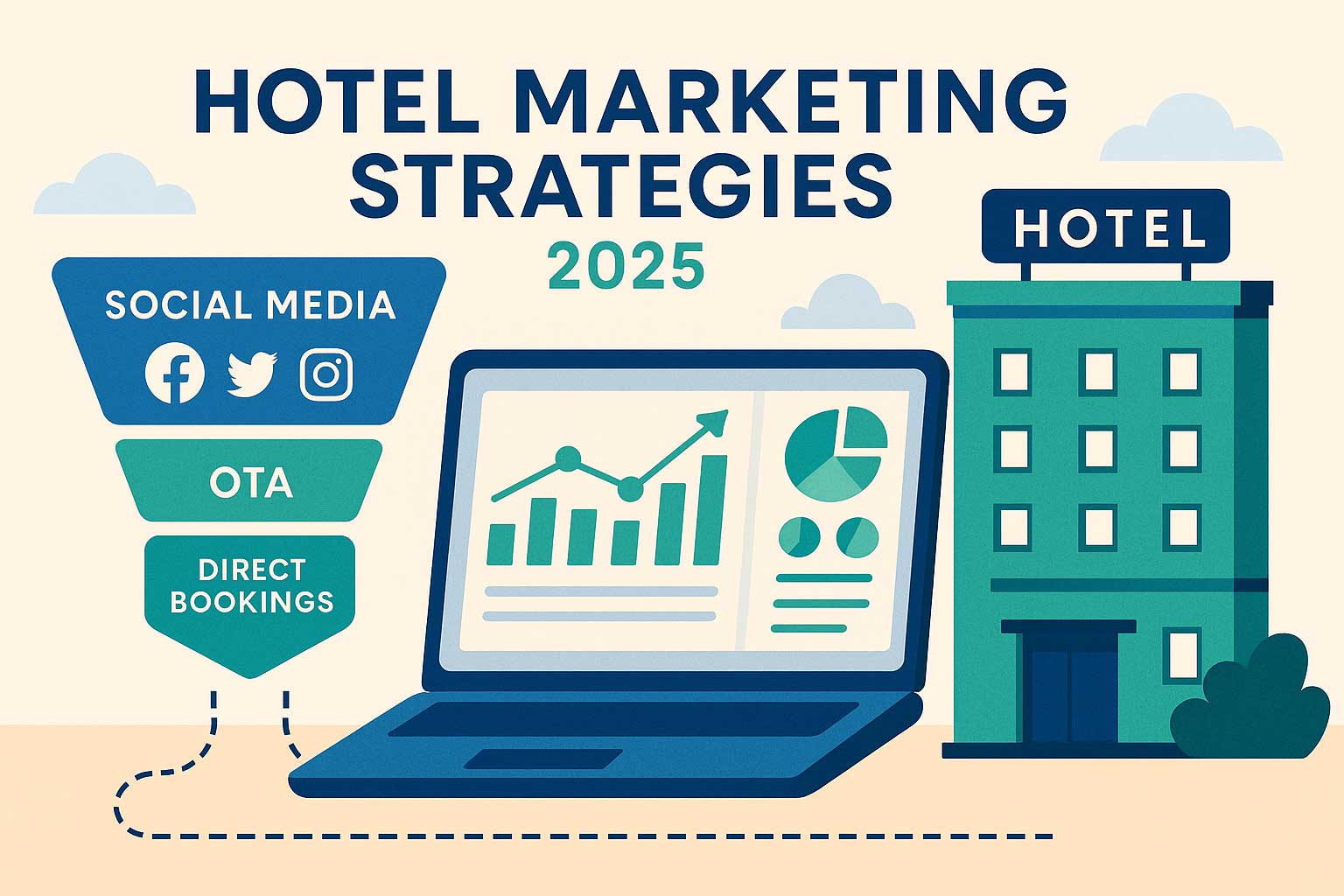GOP Meaning in Finance: Understanding Gross Operating Profit in Hotels
Aug 5, 2025
 Mika Takahashi
Mika TakahashiPopular Categories
Hotel Technology & InnovationHotel Operations OptimizationDigital MarketingIndustry TrendsRevenue ManagementHospitality Industry
Popular Categories
Trending Post

Hotel Walk Letter Template: Professional Guest Communication

Online Travel Agents: What They Are and How They Work

Hotel Security Systems: Modern Protection Solutions

Hotel Advertising: Complete Guide to Boost Bookings and Revenue

25 Hotel Marketing Strategy Ideas for 2025: Complete Guide

AI Reservation Agent: Revolutionizing Hotel Booking and Guest Experience

PMS Communication: Streamlining Property Management Through Effective Guest Messaging
Table of contents
When it comes to evaluating how well a company runs its day-to-day operations, few numbers give as clear a snapshot as gross operating profit (GOP). This key financial metric is vital across many industries—from luxury hotels keeping tabs on their profitability to manufacturers fine-tuning their processes. Grasping the GOP meaning in finance can really change the way you look at business performance and help you make smarter decisions about how to manage operations.
Simply put, GOP is the money a business keeps after paying for its operating expenses, but before factoring in costs like interest payments, taxes, and depreciation. It cuts through the noise of financing and tax details to show the real efficiency of the core business activities.
What Does GOP Mean in Finance?
GOP stands for gross operating profit, a fundamental financial measure that shows profitability after subtracting operating expenses from total revenue. Unlike net profit, which accounts for every expense, GOP zeroes in on operational performance by leaving out non-operating costs such as taxes, interest, depreciation, and amortization.

This figure represents the actual cash a business keeps from its core operations before financing and tax considerations come into play. GOP is widely used across sectors like hospitality, retail, manufacturing, and services to gauge how efficiently a company is running.
In the hospitality world, GOP is especially important. Hotels track this metric closely to gauge their hotel profitability and operational efficiency compared to competitors and industry norms.
GOP Financial Definition and Core Components
GOP reflects the profit from a company’s main business activities, spotlighting operational efficiency by focusing on revenue and direct operating costs. This number gives a transparent look at how well management controls costs while maximizing revenue from core operations.
Revenue Components
When calculating GOP, total revenue usually includes all income from primary business activities:
- Room revenue (in hotels)
- Food and beverage sales
- Ancillary revenue from extra services
- Other income streams tied directly to operations
For hotels, this means income from room sales, beverage sales, and additional guest services. The hotel’s revenue covers all money earned from occupied rooms and the extra services guests use.
Operating Expense Categories
Operating expenses cover everything needed to keep the business running daily, such as cost of goods sold, wages, utilities, rent, and administrative costs:
- Staff salaries and benefits
- Utilities and maintenance
- Supplies and inventory
- Marketing and advertising
- Fixed costs like rent and insurance
- Variable expenses that change with business volume
Getting these expenses categorized correctly is key for accurate GOP calculations and meaningful analysis. Consistency in how expenses are recorded is essential for reliable comparisons over time.
How to Calculate GOP in Finance
Calculating gross operating profit is straightforward and focuses on operational results:
Basic GOP Formula: Total Revenue - Total Operating Expenses = Gross Operating Profit
GOP Percentage Calculation: (Gross Operating Profit ÷ Total Revenue) × 100
Practical Calculation Example
Imagine a hotel with these numbers:
- Total revenue: $500,000
- Operating expenses: $350,000
- GOP calculation: $500,000 - $350,000 = $150,000
- GOP margin: ($150,000 ÷ $500,000) × 100 = 30%
This example shows how subtracting operating costs from total revenue gives you the gross operating profit. A 30% margin here signals solid operational efficiency, especially in the hotel industry.
Expense Categorization Guidelines
It’s crucial to separate operating expenses from non-operating ones:
Operating Expenses Include:
- Cost of goods sold
- Labor and payroll
- Utilities and maintenance
- Supplies and materials
- Administrative overhead
Non-Operating Expenses Exclude:
- Interest payments on loans
- Depreciation and amortization
- Income taxes
- Investment gains or losses
- One-time extraordinary costs
This clear distinction helps GOP give a true picture of operational efficiency without the noise of financing or accounting quirks.
GOP vs Other Financial Metrics
Knowing how GOP stacks up against other financial measures helps clarify its unique role in business analysis. Each metric sheds light on different parts of company performance.

GOP vs EBITDA Comparison
EBITDA (Earnings Before Interest, Taxes, Depreciation, Amortization) includes depreciation, while GOP usually excludes it. GOP zeroes in on cash-based operating expenses, making it more useful for everyday operational management and assessing immediate efficiency.
EBITDA is often used for company valuations and mergers because it approximates operational cash flow, whereas GOP is better suited for tracking how well operations are running day-to-day. Both have their place in financial analysis and investment decisions, with GOP offering more detailed operational insights.
GOP vs Net Operating Income
Net operating income (NOI) includes additional expenses like property taxes and insurance, which GOP might leave out. Because of this, GOP often shows a higher profit figure than NOI due to fewer included expenses and different accounting treatments.
NOI is more common in real estate finance, while GOP applies broadly across industries. Both help investors evaluate operational efficiency but cover different expense scopes, making GOP especially useful for comparing operational performance across various business types.
GOP vs Net Profit Margin
Net profit margin accounts for all revenues and expenses—operating and non-operating—to give a complete profitability picture after all deductions. Unlike GOP, net profit margin is heavily influenced by leverage, asset structure, and tax planning.
GOP offers a cleaner look at operational performance because it excludes financing and tax factors. This makes it especially valuable for managers and investors focused on core business efficiency rather than the overall financial setup.
Industry-Specific GOP Benchmarks
Expected GOP margins differ widely depending on the industry, reflecting variations in cost structures, revenue sources, and capital needs.
Hospitality Industry Standards
Hotels rely heavily on GOP to measure performance:
- Luxury hotels: Aim for 35-45% GOP margins by blending premium pricing with efficient operations
- Upscale hotels: Target 30-40% margins balancing quality service and cost control
- Midscale properties: Focus on 25-35% margins emphasizing operational efficiency
Hotel profit margins depend on room rates, occupancy, staff productivity, and managing variable costs like food, beverage, and maintenance. Happy guests often lead to higher GOP through better occupancy and the ability to charge premium prices.
Other Industry Benchmarks
Retail: Profit margins typically range from 20-40%, depending on product mix, operational leverage, and fixed versus variable costs.
Manufacturing: GOP percentages vary from 15-30% based on industry, automation, and competition. These businesses often invest heavily in technology and process improvements to boost margins.
Service Industries: These often see higher GOP margins (30-50%) due to lower costs of goods sold and greater potential for operational efficiency with the right technology and processes.
Why GOP Matters for Financial Analysis
GOP is a vital indicator of operational efficiency and management effectiveness across sectors. It offers insights that influence key metric evaluations and strategic choices.
Investor and Lender Perspective
Investors look to GOP to understand how well a company generates profit from its core activities without the distortion of financing or tax strategies. Banks and lenders often consider GOP when deciding on business loans, as it reflects operational cash flow potential.
Tracking GOP trends helps spot improvements or declines in performance over time, making it a useful tool for monitoring management success and business direction. It also allows meaningful comparisons between companies with different capital or tax setups.
Management Applications
Hotel managers use GOP to benchmark against competitors and set improvement goals. Revenue teams analyze it alongside occupancy and pricing to boost profitability.
This metric highlights areas where cost control or revenue growth can improve results. Regular GOP reviews enable quick responses to market changes.
Strategies to Improve GOP Performance
Boosting gross operating profit takes a balanced approach that grows revenue while controlling costs—without sacrificing service or guest satisfaction.

Revenue Optimization Techniques
Dynamic Pricing Strategies: Using smart pricing that adapts to demand, seasons, and market trends can boost revenue per sale.
Upselling and Cross-selling: Training staff to spot chances for extra services or premium options raises average spend and overall revenue.
Market Expansion: Finding new customer groups or services that use existing capacity without adding much cost.
Cost Control Measures
Energy Efficiency Programs: Cutting utility costs through energy-saving systems helps reduce one of the biggest operating expenses.
Process Automation: Technology that automates routine tasks can lower labor costs while keeping service quality high.
Vendor Negotiation: Regularly reviewing supplier deals ensures competitive prices without sacrificing quality.
Operational Efficiency Improvements
Staff Training and Development: Skilled employees work better, offer superior guest service, and boost satisfaction and loyalty.
Workflow Optimization: Streamlining processes cuts waste and saves time and resources.
Technology Integration: The right tech tools improve accuracy and free staff to focus on revenue-generating work.
GOP Limitations and Considerations
While GOP is valuable, it has limits that should be kept in mind during financial analysis.
What GOP Doesn’t Include
GOP doesn’t cover capital expenditures, depreciation, or long-term investments that can heavily impact profitability and cash flow. It may not reflect true profitability if non-operating expenses or large capital projects are significant.
Because it leaves out interest payments, GOP doesn’t show how financing decisions affect actual cash flow to owners and investors. Taxes are also excluded, which can greatly influence net returns.
Contextual Analysis Requirements
GOP should be viewed alongside other financial metrics for a full business picture. The income statement includes all revenues and expenses affecting actual profit.
Industry factors and seasonal swings can affect GOP comparisons between companies or over time. Knowing these influences is key for accurate interpretation and benchmarking.
Best Practices for GOP Analysis
Using consistent accounting and expense classification ensures meaningful trend tracking. Comparing GOP to industry standards helps spot performance gaps and opportunities.
Combining GOP with operational metrics like occupancy, daily rates, and customer satisfaction gives a complete view for smart business decisions.
Understanding GOP and GOPPAR in the Hospitality Industry
GOP (Gross Operating Profit) and GOPPAR (Gross Operating Profit Per Available Room) often come up together. Both measure hotel profitability and efficiency, but they look at different angles.
What is GOPPAR?
GOPPAR refines GOP by dividing gross operating profit by the total available rooms over a time period. This gives a per-room profitability measure, making it easier to compare hotels of different sizes or track performance over time.
The formula is:
GOPPAR = Gross Operating Profit ÷ Total Available Room Nights
By focusing on profit per available room, GOPPAR considers both revenue and operational efficiency relative to hotel capacity. This makes it a valuable benchmark against competitors and industry averages.
Key Differences Between GOP and GOPPAR
- Scope: GOP measures total operational profit, while GOPPAR relates profit to room availability.
- Comparability: GOPPAR allows fair comparison across hotels with different sizes and occupancy, while GOP is an absolute number.
- Usage: GOP helps understand overall profitability; GOPPAR is ideal for benchmarking and efficiency analysis.
Why Are GOP and GOPPAR Important?
Together, these metrics offer a full picture of a hotel’s financial health. GOP shows how well costs are controlled and profit generated from revenue streams. GOPPAR adds context by factoring in hotel size and capacity, showing how effectively rooms are used to maximize profit.
Hotel operators use both to guide revenue management, cost control, and operational improvements. Investors and lenders also rely on them to assess financial viability and operational success.
In short, knowing both GOP and GOPPAR is essential for hotel management and investment, highlighting operational efficiency, profitability, and revenue generation per room.
Conclusion
Getting a handle on the GOP meaning in finance unlocks key insights into operational efficiency that simple profit numbers can’t provide. It cuts through financing, tax, and accounting complexities to reveal how well a business makes money from its core activities.
From luxury hotels fine-tuning operations to manufacturers streamlining production, GOP is a vital tool for measuring and improving performance. Its focus on operational cash flow makes it especially useful for everyday management and strategy.
That said, GOP works best alongside other metrics like net profit margin, cash flow, and industry benchmarks. Combining GOP with operational data and market insights helps businesses make smarter decisions on pricing, cost control, and improvements.
Whether you’re analyzing hotel profitability, manufacturing efficiency, or service performance, GOP offers the clarity needed to drive growth and stronger financial health.
